Impact of Supply Chains and Logistics on Business Development
VerifiedAdded on 2020/10/22
|11
|3698
|311
Report
AI Summary
This report provides an in-depth analysis of supply chains and logistics, focusing on their critical role in business development and success. It begins by defining key concepts such as globalization, logistics, and supply chain management, highlighting their interdependencies and impact on organizational operations. The report then critically examines the statement, "The success and failure of supply chains are ultimately determined in the marketplace by the end consumer. Getting the right product, at the right price, at the right time to the consumer is not only the lynchpin to competitive success but also the key to survival…" with a specific emphasis on the lean thinking paradigm. The analysis explores how consumer satisfaction, efficient logistics, and effective supply chain management are vital for achieving competitive advantage and ensuring business survival. The report emphasizes the consumer's pivotal role in shaping supply chain strategies and driving improvements in business operations, considering factors like customer service, product availability, and the impact of e-commerce. The report concludes with recommendations for improving supply chain metrics and adapting to consumer demands.
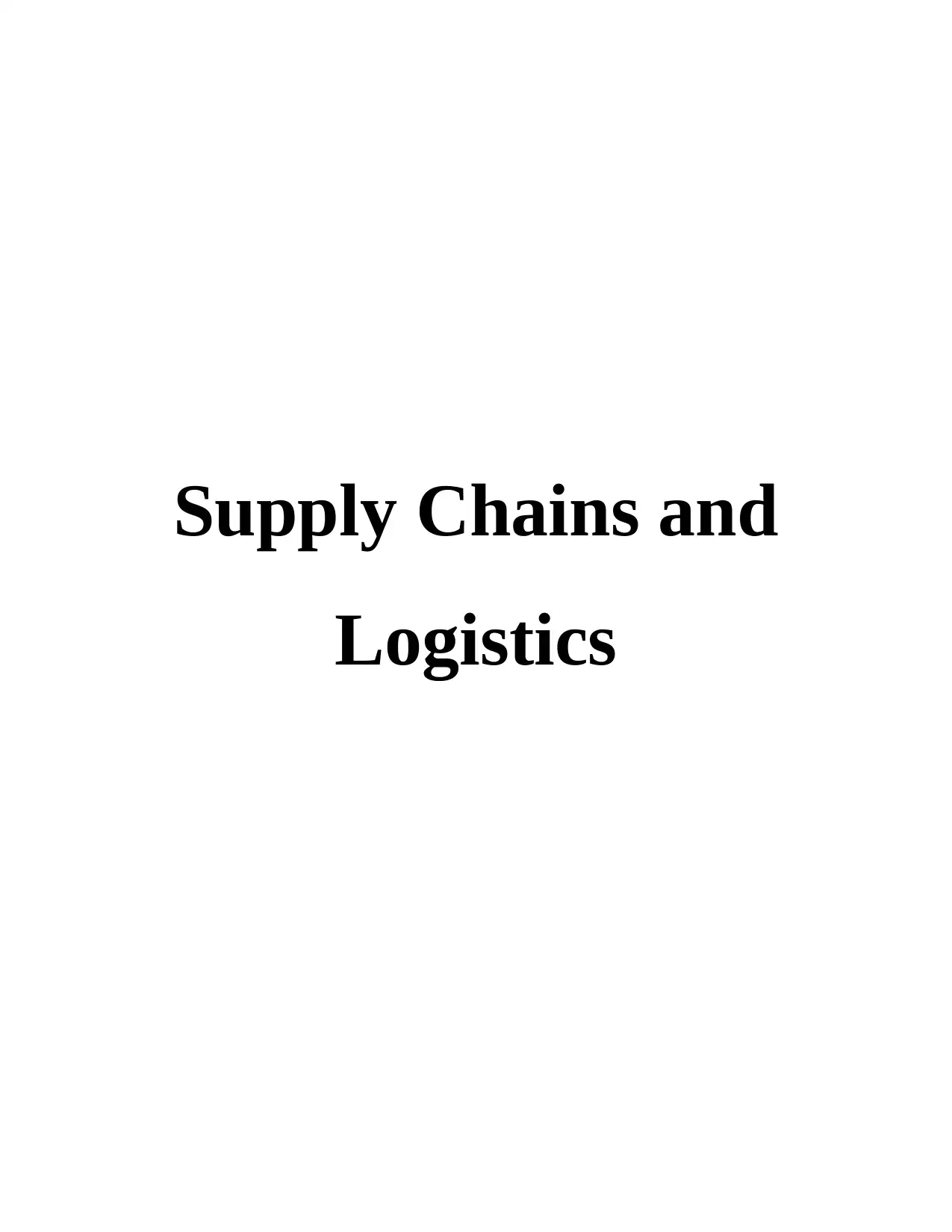
Supply Chains and
Logistics
Logistics
Paraphrase This Document
Need a fresh take? Get an instant paraphrase of this document with our AI Paraphraser

TABLE OF CONTENTS
INTRODUCTION...........................................................................................................................1
MAIN CONCEPTS.........................................................................................................................1
Explaining concept of Globalisation, logistics and supply chain................................................1
Critically analyze the statement “The success and failure of supply chains are ultimately
determined in the marketplace by the end consumer. Getting the right product, at the right
price, at the right time to the consumer is not only the lynchpin to competitive success but also
the key to survival…” with a special focus on the lean thinking paradigm................................3
CONCLUSION................................................................................................................................7
RECOMMENDATIONS.................................................................................................................7
REFERENCES................................................................................................................................8
INTRODUCTION...........................................................................................................................1
MAIN CONCEPTS.........................................................................................................................1
Explaining concept of Globalisation, logistics and supply chain................................................1
Critically analyze the statement “The success and failure of supply chains are ultimately
determined in the marketplace by the end consumer. Getting the right product, at the right
price, at the right time to the consumer is not only the lynchpin to competitive success but also
the key to survival…” with a special focus on the lean thinking paradigm................................3
CONCLUSION................................................................................................................................7
RECOMMENDATIONS.................................................................................................................7
REFERENCES................................................................................................................................8
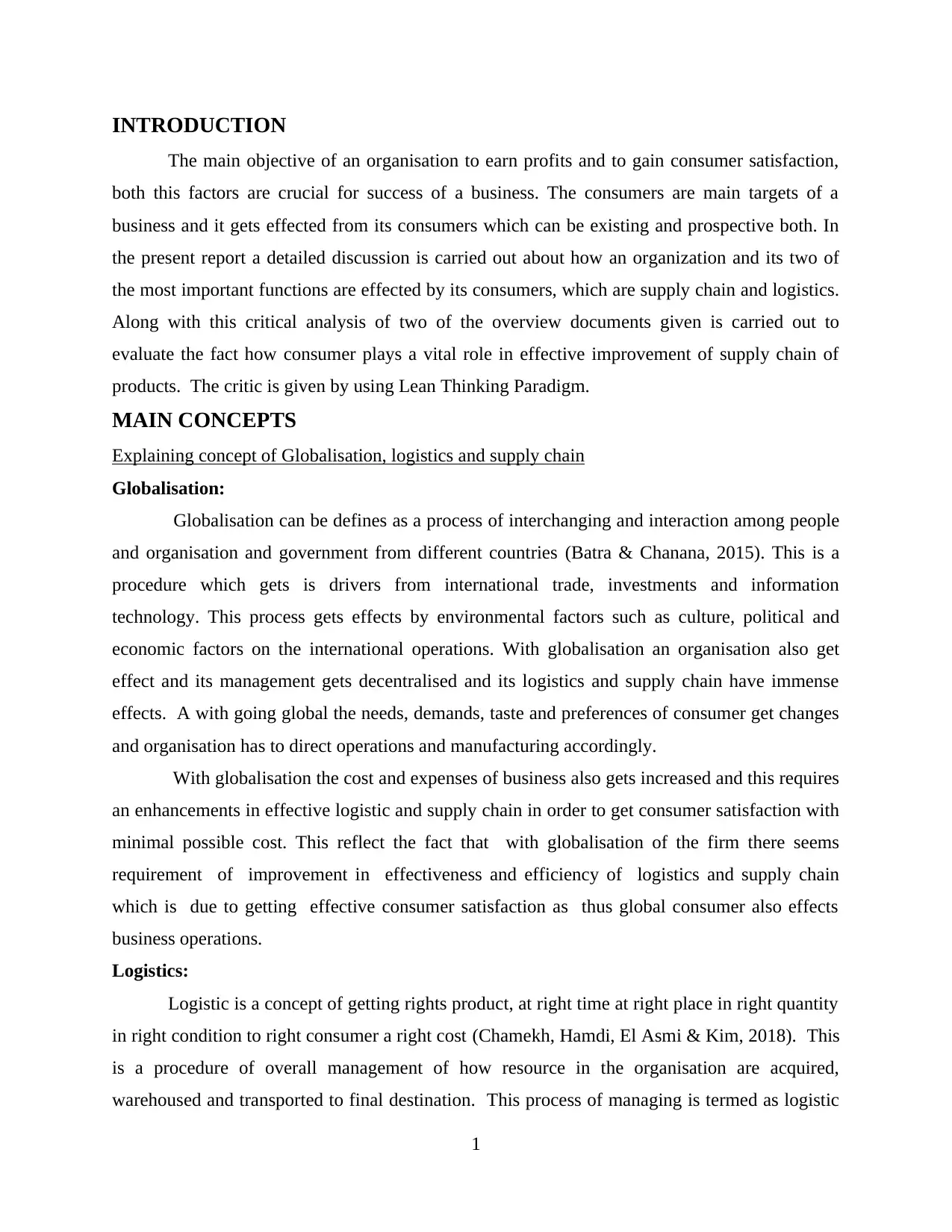
INTRODUCTION
The main objective of an organisation to earn profits and to gain consumer satisfaction,
both this factors are crucial for success of a business. The consumers are main targets of a
business and it gets effected from its consumers which can be existing and prospective both. In
the present report a detailed discussion is carried out about how an organization and its two of
the most important functions are effected by its consumers, which are supply chain and logistics.
Along with this critical analysis of two of the overview documents given is carried out to
evaluate the fact how consumer plays a vital role in effective improvement of supply chain of
products. The critic is given by using Lean Thinking Paradigm.
MAIN CONCEPTS
Explaining concept of Globalisation, logistics and supply chain
Globalisation:
Globalisation can be defines as a process of interchanging and interaction among people
and organisation and government from different countries (Batra & Chanana, 2015). This is a
procedure which gets is drivers from international trade, investments and information
technology. This process gets effects by environmental factors such as culture, political and
economic factors on the international operations. With globalisation an organisation also get
effect and its management gets decentralised and its logistics and supply chain have immense
effects. A with going global the needs, demands, taste and preferences of consumer get changes
and organisation has to direct operations and manufacturing accordingly.
With globalisation the cost and expenses of business also gets increased and this requires
an enhancements in effective logistic and supply chain in order to get consumer satisfaction with
minimal possible cost. This reflect the fact that with globalisation of the firm there seems
requirement of improvement in effectiveness and efficiency of logistics and supply chain
which is due to getting effective consumer satisfaction as thus global consumer also effects
business operations.
Logistics:
Logistic is a concept of getting rights product, at right time at right place in right quantity
in right condition to right consumer a right cost (Chamekh, Hamdi, El Asmi & Kim, 2018). This
is a procedure of overall management of how resource in the organisation are acquired,
warehoused and transported to final destination. This process of managing is termed as logistic
1
The main objective of an organisation to earn profits and to gain consumer satisfaction,
both this factors are crucial for success of a business. The consumers are main targets of a
business and it gets effected from its consumers which can be existing and prospective both. In
the present report a detailed discussion is carried out about how an organization and its two of
the most important functions are effected by its consumers, which are supply chain and logistics.
Along with this critical analysis of two of the overview documents given is carried out to
evaluate the fact how consumer plays a vital role in effective improvement of supply chain of
products. The critic is given by using Lean Thinking Paradigm.
MAIN CONCEPTS
Explaining concept of Globalisation, logistics and supply chain
Globalisation:
Globalisation can be defines as a process of interchanging and interaction among people
and organisation and government from different countries (Batra & Chanana, 2015). This is a
procedure which gets is drivers from international trade, investments and information
technology. This process gets effects by environmental factors such as culture, political and
economic factors on the international operations. With globalisation an organisation also get
effect and its management gets decentralised and its logistics and supply chain have immense
effects. A with going global the needs, demands, taste and preferences of consumer get changes
and organisation has to direct operations and manufacturing accordingly.
With globalisation the cost and expenses of business also gets increased and this requires
an enhancements in effective logistic and supply chain in order to get consumer satisfaction with
minimal possible cost. This reflect the fact that with globalisation of the firm there seems
requirement of improvement in effectiveness and efficiency of logistics and supply chain
which is due to getting effective consumer satisfaction as thus global consumer also effects
business operations.
Logistics:
Logistic is a concept of getting rights product, at right time at right place in right quantity
in right condition to right consumer a right cost (Chamekh, Hamdi, El Asmi & Kim, 2018). This
is a procedure of overall management of how resource in the organisation are acquired,
warehoused and transported to final destination. This process of managing is termed as logistic
1
⊘ This is a preview!⊘
Do you want full access?
Subscribe today to unlock all pages.

Trusted by 1+ million students worldwide
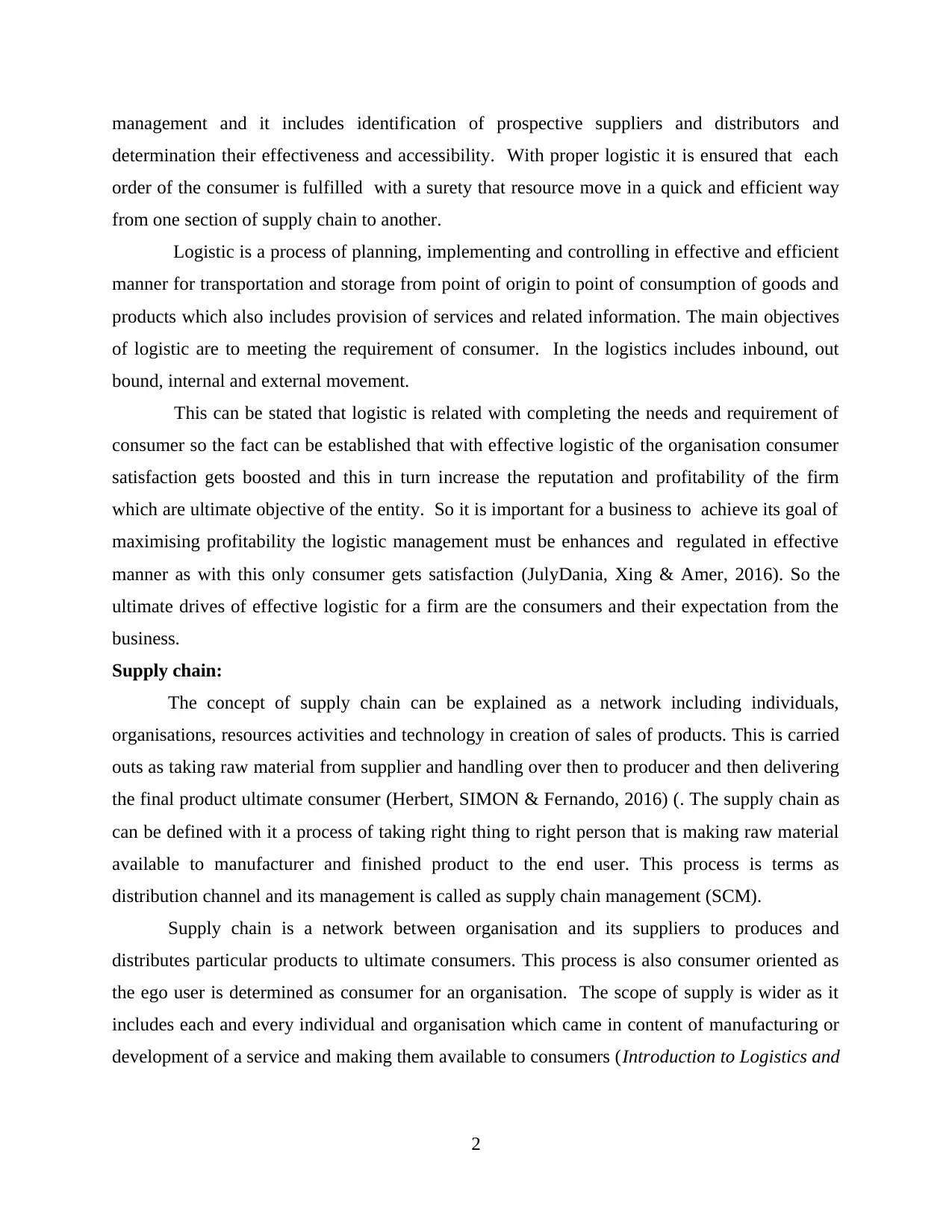
management and it includes identification of prospective suppliers and distributors and
determination their effectiveness and accessibility. With proper logistic it is ensured that each
order of the consumer is fulfilled with a surety that resource move in a quick and efficient way
from one section of supply chain to another.
Logistic is a process of planning, implementing and controlling in effective and efficient
manner for transportation and storage from point of origin to point of consumption of goods and
products which also includes provision of services and related information. The main objectives
of logistic are to meeting the requirement of consumer. In the logistics includes inbound, out
bound, internal and external movement.
This can be stated that logistic is related with completing the needs and requirement of
consumer so the fact can be established that with effective logistic of the organisation consumer
satisfaction gets boosted and this in turn increase the reputation and profitability of the firm
which are ultimate objective of the entity. So it is important for a business to achieve its goal of
maximising profitability the logistic management must be enhances and regulated in effective
manner as with this only consumer gets satisfaction (JulyDania, Xing & Amer, 2016). So the
ultimate drives of effective logistic for a firm are the consumers and their expectation from the
business.
Supply chain:
The concept of supply chain can be explained as a network including individuals,
organisations, resources activities and technology in creation of sales of products. This is carried
outs as taking raw material from supplier and handling over then to producer and then delivering
the final product ultimate consumer (Herbert, SIMON & Fernando, 2016) (. The supply chain as
can be defined with it a process of taking right thing to right person that is making raw material
available to manufacturer and finished product to the end user. This process is terms as
distribution channel and its management is called as supply chain management (SCM).
Supply chain is a network between organisation and its suppliers to produces and
distributes particular products to ultimate consumers. This process is also consumer oriented as
the ego user is determined as consumer for an organisation. The scope of supply is wider as it
includes each and every individual and organisation which came in content of manufacturing or
development of a service and making them available to consumers (Introduction to Logistics and
2
determination their effectiveness and accessibility. With proper logistic it is ensured that each
order of the consumer is fulfilled with a surety that resource move in a quick and efficient way
from one section of supply chain to another.
Logistic is a process of planning, implementing and controlling in effective and efficient
manner for transportation and storage from point of origin to point of consumption of goods and
products which also includes provision of services and related information. The main objectives
of logistic are to meeting the requirement of consumer. In the logistics includes inbound, out
bound, internal and external movement.
This can be stated that logistic is related with completing the needs and requirement of
consumer so the fact can be established that with effective logistic of the organisation consumer
satisfaction gets boosted and this in turn increase the reputation and profitability of the firm
which are ultimate objective of the entity. So it is important for a business to achieve its goal of
maximising profitability the logistic management must be enhances and regulated in effective
manner as with this only consumer gets satisfaction (JulyDania, Xing & Amer, 2016). So the
ultimate drives of effective logistic for a firm are the consumers and their expectation from the
business.
Supply chain:
The concept of supply chain can be explained as a network including individuals,
organisations, resources activities and technology in creation of sales of products. This is carried
outs as taking raw material from supplier and handling over then to producer and then delivering
the final product ultimate consumer (Herbert, SIMON & Fernando, 2016) (. The supply chain as
can be defined with it a process of taking right thing to right person that is making raw material
available to manufacturer and finished product to the end user. This process is terms as
distribution channel and its management is called as supply chain management (SCM).
Supply chain is a network between organisation and its suppliers to produces and
distributes particular products to ultimate consumers. This process is also consumer oriented as
the ego user is determined as consumer for an organisation. The scope of supply is wider as it
includes each and every individual and organisation which came in content of manufacturing or
development of a service and making them available to consumers (Introduction to Logistics and
2
Paraphrase This Document
Need a fresh take? Get an instant paraphrase of this document with our AI Paraphraser
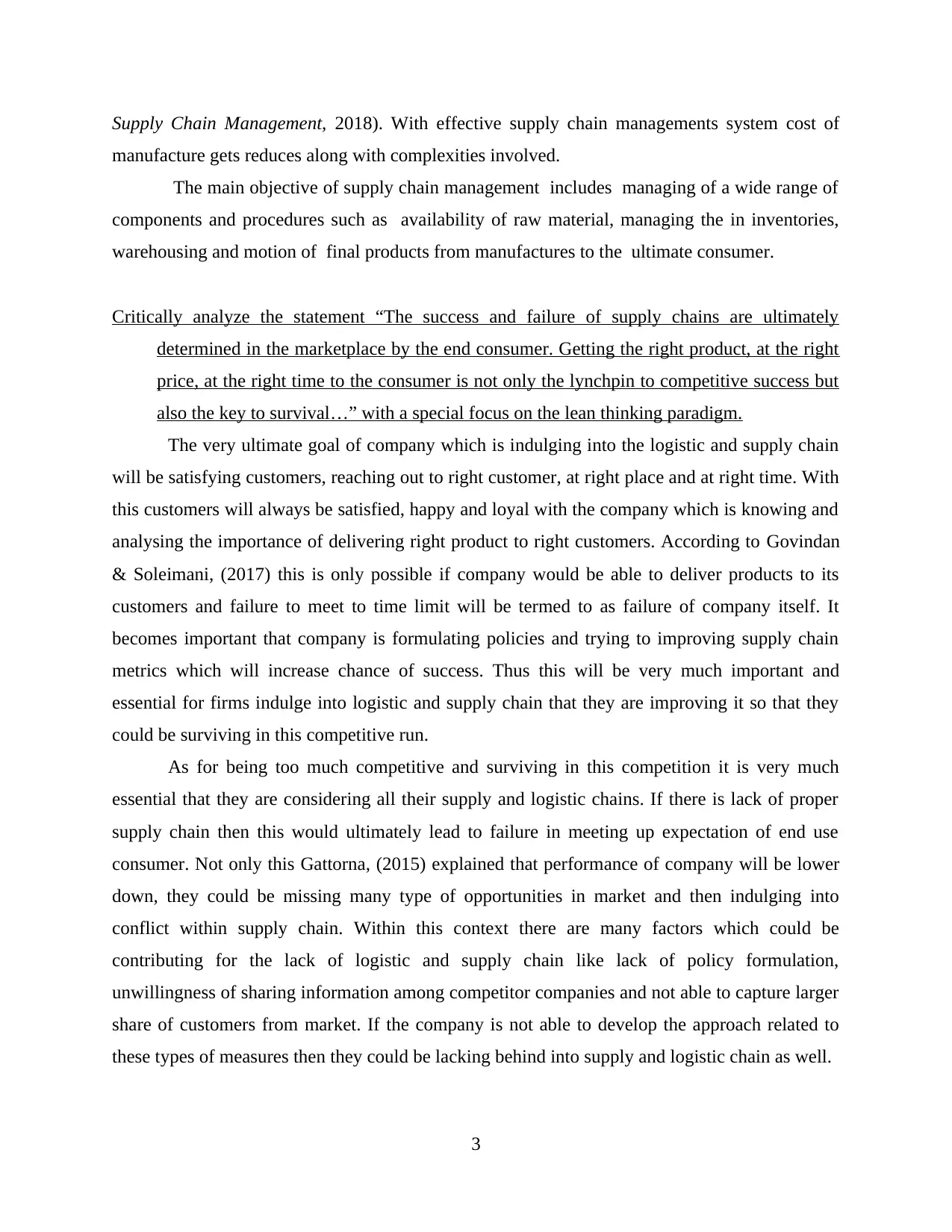
Supply Chain Management, 2018). With effective supply chain managements system cost of
manufacture gets reduces along with complexities involved.
The main objective of supply chain management includes managing of a wide range of
components and procedures such as availability of raw material, managing the in inventories,
warehousing and motion of final products from manufactures to the ultimate consumer.
Critically analyze the statement “The success and failure of supply chains are ultimately
determined in the marketplace by the end consumer. Getting the right product, at the right
price, at the right time to the consumer is not only the lynchpin to competitive success but
also the key to survival…” with a special focus on the lean thinking paradigm.
The very ultimate goal of company which is indulging into the logistic and supply chain
will be satisfying customers, reaching out to right customer, at right place and at right time. With
this customers will always be satisfied, happy and loyal with the company which is knowing and
analysing the importance of delivering right product to right customers. According to Govindan
& Soleimani, (2017) this is only possible if company would be able to deliver products to its
customers and failure to meet to time limit will be termed to as failure of company itself. It
becomes important that company is formulating policies and trying to improving supply chain
metrics which will increase chance of success. Thus this will be very much important and
essential for firms indulge into logistic and supply chain that they are improving it so that they
could be surviving in this competitive run.
As for being too much competitive and surviving in this competition it is very much
essential that they are considering all their supply and logistic chains. If there is lack of proper
supply chain then this would ultimately lead to failure in meeting up expectation of end use
consumer. Not only this Gattorna, (2015) explained that performance of company will be lower
down, they could be missing many type of opportunities in market and then indulging into
conflict within supply chain. Within this context there are many factors which could be
contributing for the lack of logistic and supply chain like lack of policy formulation,
unwillingness of sharing information among competitor companies and not able to capture larger
share of customers from market. If the company is not able to develop the approach related to
these types of measures then they could be lacking behind into supply and logistic chain as well.
3
manufacture gets reduces along with complexities involved.
The main objective of supply chain management includes managing of a wide range of
components and procedures such as availability of raw material, managing the in inventories,
warehousing and motion of final products from manufactures to the ultimate consumer.
Critically analyze the statement “The success and failure of supply chains are ultimately
determined in the marketplace by the end consumer. Getting the right product, at the right
price, at the right time to the consumer is not only the lynchpin to competitive success but
also the key to survival…” with a special focus on the lean thinking paradigm.
The very ultimate goal of company which is indulging into the logistic and supply chain
will be satisfying customers, reaching out to right customer, at right place and at right time. With
this customers will always be satisfied, happy and loyal with the company which is knowing and
analysing the importance of delivering right product to right customers. According to Govindan
& Soleimani, (2017) this is only possible if company would be able to deliver products to its
customers and failure to meet to time limit will be termed to as failure of company itself. It
becomes important that company is formulating policies and trying to improving supply chain
metrics which will increase chance of success. Thus this will be very much important and
essential for firms indulge into logistic and supply chain that they are improving it so that they
could be surviving in this competitive run.
As for being too much competitive and surviving in this competition it is very much
essential that they are considering all their supply and logistic chains. If there is lack of proper
supply chain then this would ultimately lead to failure in meeting up expectation of end use
consumer. Not only this Gattorna, (2015) explained that performance of company will be lower
down, they could be missing many type of opportunities in market and then indulging into
conflict within supply chain. Within this context there are many factors which could be
contributing for the lack of logistic and supply chain like lack of policy formulation,
unwillingness of sharing information among competitor companies and not able to capture larger
share of customers from market. If the company is not able to develop the approach related to
these types of measures then they could be lacking behind into supply and logistic chain as well.
3

As it was included by Choi, Wallace & Wang, (2016) that customer service and their
satisfaction is very much essential as this could help company to differentiate themselves from
their competitors in market. As if company is able to provide very good service to its regular
customers then they will be remained loyal with company and if they are providing good service
to new customers then they could be sources of increased in customer base. The main purpose or
mission of logistic department of company will be serving their customer as well or better that
other competitive firms with this making profits as well. Customer’s service is the chain of sales
activities and meeting customer requirements, which begin with receiving order and end with
delivery of products and service to them.
The role of customer service is to provide time and place utilities in the transfer of goods
and services between the manufacturer and the customer. In another form, the product has no
value until it is in the hands of the customer. Explained by Christopher, (2016) that availability is
a complex concept, influenced by many factors that together form the customer service. These
factors include the frequency of the delivery and its safety, the stock level and the time interval
the order is released. Companies that compete only on product characteristics have a big
disadvantage against companies that enhance the basic product with value added services.
Whoever first said that "people do not buy products, but benefits" was Theodore Levitt, one of
the greatest thinkers in marketing.
The product in the hands of the customer is much more valuable than the product in the
warehouse of the unit as justified by Schönsleben, (2016). The distribution service was, in this
case, the added value source. But in other cases, advertising, branding, packaging can increase
the product value perceived by the customer. The logistic system involves the connection
between the business and its customers for the procurement and stockpiling of materials, the
implementation and the physical distribution of products, so that the firm manages to meet
customer requirements. The logistic system provides an overview of the movement of goods and
services from the supplier to the end user and the movement of payments and information in
reverse sense.
According to Ugarte, Golden & Dooley, (2016) between the business and the customers
there are close relationships that allow identifying the benefits from the strategic point of view of
the system functionality. The management’s attention should focus not only on the business, but
also on the interactions giving logistical system functionality. Some experts consider that
4
satisfaction is very much essential as this could help company to differentiate themselves from
their competitors in market. As if company is able to provide very good service to its regular
customers then they will be remained loyal with company and if they are providing good service
to new customers then they could be sources of increased in customer base. The main purpose or
mission of logistic department of company will be serving their customer as well or better that
other competitive firms with this making profits as well. Customer’s service is the chain of sales
activities and meeting customer requirements, which begin with receiving order and end with
delivery of products and service to them.
The role of customer service is to provide time and place utilities in the transfer of goods
and services between the manufacturer and the customer. In another form, the product has no
value until it is in the hands of the customer. Explained by Christopher, (2016) that availability is
a complex concept, influenced by many factors that together form the customer service. These
factors include the frequency of the delivery and its safety, the stock level and the time interval
the order is released. Companies that compete only on product characteristics have a big
disadvantage against companies that enhance the basic product with value added services.
Whoever first said that "people do not buy products, but benefits" was Theodore Levitt, one of
the greatest thinkers in marketing.
The product in the hands of the customer is much more valuable than the product in the
warehouse of the unit as justified by Schönsleben, (2016). The distribution service was, in this
case, the added value source. But in other cases, advertising, branding, packaging can increase
the product value perceived by the customer. The logistic system involves the connection
between the business and its customers for the procurement and stockpiling of materials, the
implementation and the physical distribution of products, so that the firm manages to meet
customer requirements. The logistic system provides an overview of the movement of goods and
services from the supplier to the end user and the movement of payments and information in
reverse sense.
According to Ugarte, Golden & Dooley, (2016) between the business and the customers
there are close relationships that allow identifying the benefits from the strategic point of view of
the system functionality. The management’s attention should focus not only on the business, but
also on the interactions giving logistical system functionality. Some experts consider that
4
⊘ This is a preview!⊘
Do you want full access?
Subscribe today to unlock all pages.

Trusted by 1+ million students worldwide
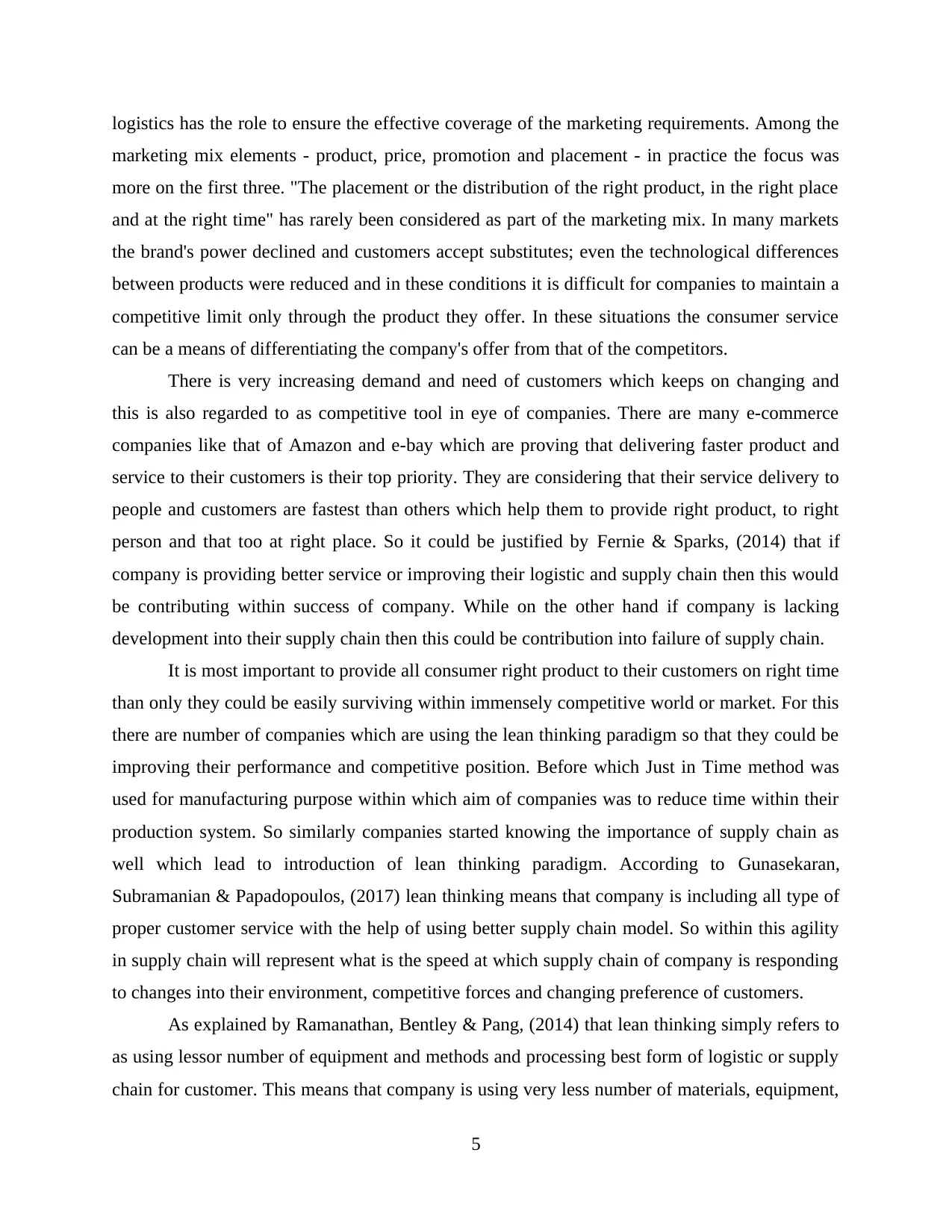
logistics has the role to ensure the effective coverage of the marketing requirements. Among the
marketing mix elements - product, price, promotion and placement - in practice the focus was
more on the first three. "The placement or the distribution of the right product, in the right place
and at the right time" has rarely been considered as part of the marketing mix. In many markets
the brand's power declined and customers accept substitutes; even the technological differences
between products were reduced and in these conditions it is difficult for companies to maintain a
competitive limit only through the product they offer. In these situations the consumer service
can be a means of differentiating the company's offer from that of the competitors.
There is very increasing demand and need of customers which keeps on changing and
this is also regarded to as competitive tool in eye of companies. There are many e-commerce
companies like that of Amazon and e-bay which are proving that delivering faster product and
service to their customers is their top priority. They are considering that their service delivery to
people and customers are fastest than others which help them to provide right product, to right
person and that too at right place. So it could be justified by Fernie & Sparks, (2014) that if
company is providing better service or improving their logistic and supply chain then this would
be contributing within success of company. While on the other hand if company is lacking
development into their supply chain then this could be contribution into failure of supply chain.
It is most important to provide all consumer right product to their customers on right time
than only they could be easily surviving within immensely competitive world or market. For this
there are number of companies which are using the lean thinking paradigm so that they could be
improving their performance and competitive position. Before which Just in Time method was
used for manufacturing purpose within which aim of companies was to reduce time within their
production system. So similarly companies started knowing the importance of supply chain as
well which lead to introduction of lean thinking paradigm. According to Gunasekaran,
Subramanian & Papadopoulos, (2017) lean thinking means that company is including all type of
proper customer service with the help of using better supply chain model. So within this agility
in supply chain will represent what is the speed at which supply chain of company is responding
to changes into their environment, competitive forces and changing preference of customers.
As explained by Ramanathan, Bentley & Pang, (2014) that lean thinking simply refers to
as using lessor number of equipment and methods and processing best form of logistic or supply
chain for customer. This means that company is using very less number of materials, equipment,
5
marketing mix elements - product, price, promotion and placement - in practice the focus was
more on the first three. "The placement or the distribution of the right product, in the right place
and at the right time" has rarely been considered as part of the marketing mix. In many markets
the brand's power declined and customers accept substitutes; even the technological differences
between products were reduced and in these conditions it is difficult for companies to maintain a
competitive limit only through the product they offer. In these situations the consumer service
can be a means of differentiating the company's offer from that of the competitors.
There is very increasing demand and need of customers which keeps on changing and
this is also regarded to as competitive tool in eye of companies. There are many e-commerce
companies like that of Amazon and e-bay which are proving that delivering faster product and
service to their customers is their top priority. They are considering that their service delivery to
people and customers are fastest than others which help them to provide right product, to right
person and that too at right place. So it could be justified by Fernie & Sparks, (2014) that if
company is providing better service or improving their logistic and supply chain then this would
be contributing within success of company. While on the other hand if company is lacking
development into their supply chain then this could be contribution into failure of supply chain.
It is most important to provide all consumer right product to their customers on right time
than only they could be easily surviving within immensely competitive world or market. For this
there are number of companies which are using the lean thinking paradigm so that they could be
improving their performance and competitive position. Before which Just in Time method was
used for manufacturing purpose within which aim of companies was to reduce time within their
production system. So similarly companies started knowing the importance of supply chain as
well which lead to introduction of lean thinking paradigm. According to Gunasekaran,
Subramanian & Papadopoulos, (2017) lean thinking means that company is including all type of
proper customer service with the help of using better supply chain model. So within this agility
in supply chain will represent what is the speed at which supply chain of company is responding
to changes into their environment, competitive forces and changing preference of customers.
As explained by Ramanathan, Bentley & Pang, (2014) that lean thinking simply refers to
as using lessor number of equipment and methods and processing best form of logistic or supply
chain for customer. This means that company is using very less number of materials, equipment,
5
Paraphrase This Document
Need a fresh take? Get an instant paraphrase of this document with our AI Paraphraser
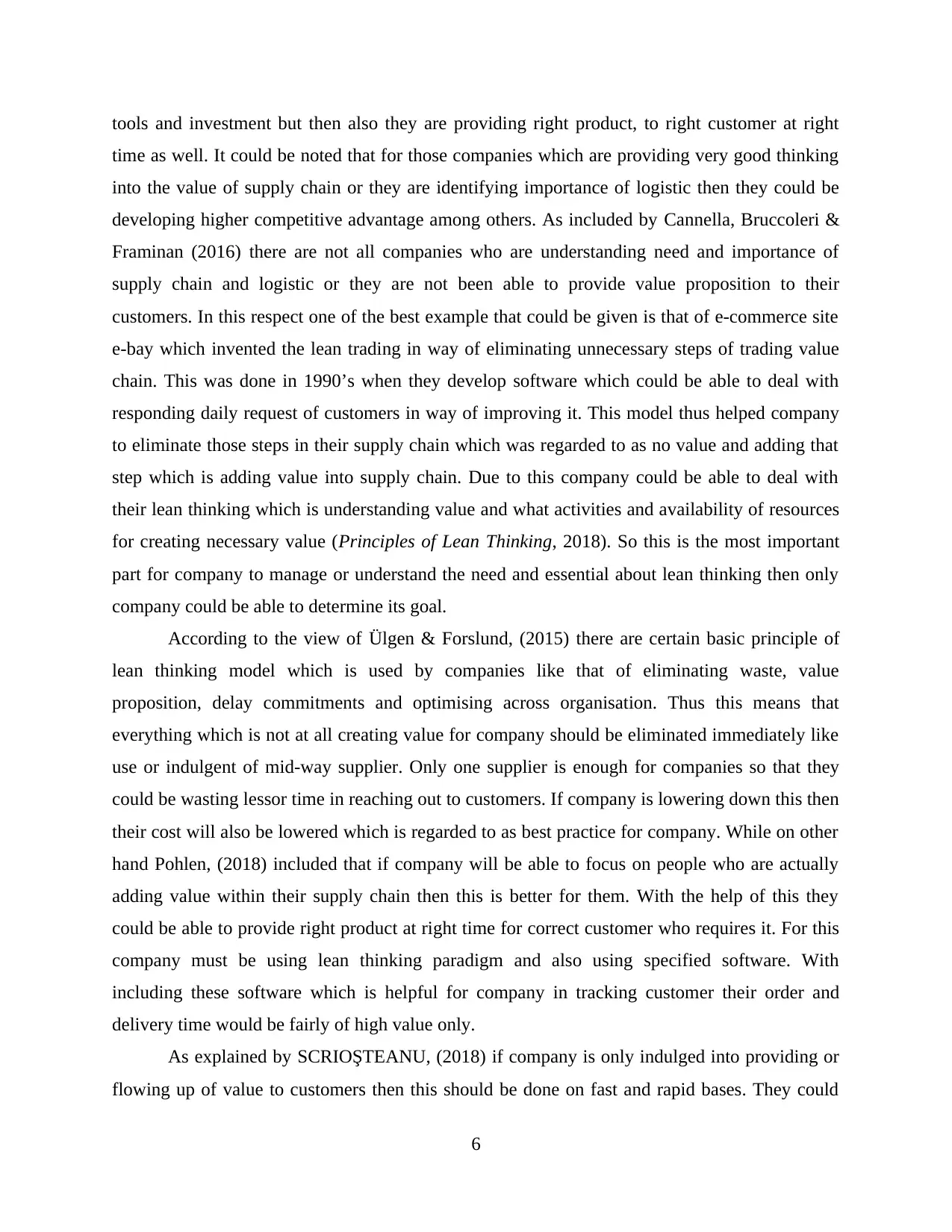
tools and investment but then also they are providing right product, to right customer at right
time as well. It could be noted that for those companies which are providing very good thinking
into the value of supply chain or they are identifying importance of logistic then they could be
developing higher competitive advantage among others. As included by Cannella, Bruccoleri &
Framinan (2016) there are not all companies who are understanding need and importance of
supply chain and logistic or they are not been able to provide value proposition to their
customers. In this respect one of the best example that could be given is that of e-commerce site
e-bay which invented the lean trading in way of eliminating unnecessary steps of trading value
chain. This was done in 1990’s when they develop software which could be able to deal with
responding daily request of customers in way of improving it. This model thus helped company
to eliminate those steps in their supply chain which was regarded to as no value and adding that
step which is adding value into supply chain. Due to this company could be able to deal with
their lean thinking which is understanding value and what activities and availability of resources
for creating necessary value (Principles of Lean Thinking, 2018). So this is the most important
part for company to manage or understand the need and essential about lean thinking then only
company could be able to determine its goal.
According to the view of Ülgen & Forslund, (2015) there are certain basic principle of
lean thinking model which is used by companies like that of eliminating waste, value
proposition, delay commitments and optimising across organisation. Thus this means that
everything which is not at all creating value for company should be eliminated immediately like
use or indulgent of mid-way supplier. Only one supplier is enough for companies so that they
could be wasting lessor time in reaching out to customers. If company is lowering down this then
their cost will also be lowered which is regarded to as best practice for company. While on other
hand Pohlen, (2018) included that if company will be able to focus on people who are actually
adding value within their supply chain then this is better for them. With the help of this they
could be able to provide right product at right time for correct customer who requires it. For this
company must be using lean thinking paradigm and also using specified software. With
including these software which is helpful for company in tracking customer their order and
delivery time would be fairly of high value only.
As explained by SCRIOŞTEANU, (2018) if company is only indulged into providing or
flowing up of value to customers then this should be done on fast and rapid bases. They could
6
time as well. It could be noted that for those companies which are providing very good thinking
into the value of supply chain or they are identifying importance of logistic then they could be
developing higher competitive advantage among others. As included by Cannella, Bruccoleri &
Framinan (2016) there are not all companies who are understanding need and importance of
supply chain and logistic or they are not been able to provide value proposition to their
customers. In this respect one of the best example that could be given is that of e-commerce site
e-bay which invented the lean trading in way of eliminating unnecessary steps of trading value
chain. This was done in 1990’s when they develop software which could be able to deal with
responding daily request of customers in way of improving it. This model thus helped company
to eliminate those steps in their supply chain which was regarded to as no value and adding that
step which is adding value into supply chain. Due to this company could be able to deal with
their lean thinking which is understanding value and what activities and availability of resources
for creating necessary value (Principles of Lean Thinking, 2018). So this is the most important
part for company to manage or understand the need and essential about lean thinking then only
company could be able to determine its goal.
According to the view of Ülgen & Forslund, (2015) there are certain basic principle of
lean thinking model which is used by companies like that of eliminating waste, value
proposition, delay commitments and optimising across organisation. Thus this means that
everything which is not at all creating value for company should be eliminated immediately like
use or indulgent of mid-way supplier. Only one supplier is enough for companies so that they
could be wasting lessor time in reaching out to customers. If company is lowering down this then
their cost will also be lowered which is regarded to as best practice for company. While on other
hand Pohlen, (2018) included that if company will be able to focus on people who are actually
adding value within their supply chain then this is better for them. With the help of this they
could be able to provide right product at right time for correct customer who requires it. For this
company must be using lean thinking paradigm and also using specified software. With
including these software which is helpful for company in tracking customer their order and
delivery time would be fairly of high value only.
As explained by SCRIOŞTEANU, (2018) if company is only indulged into providing or
flowing up of value to customers then this should be done on fast and rapid bases. They could
6
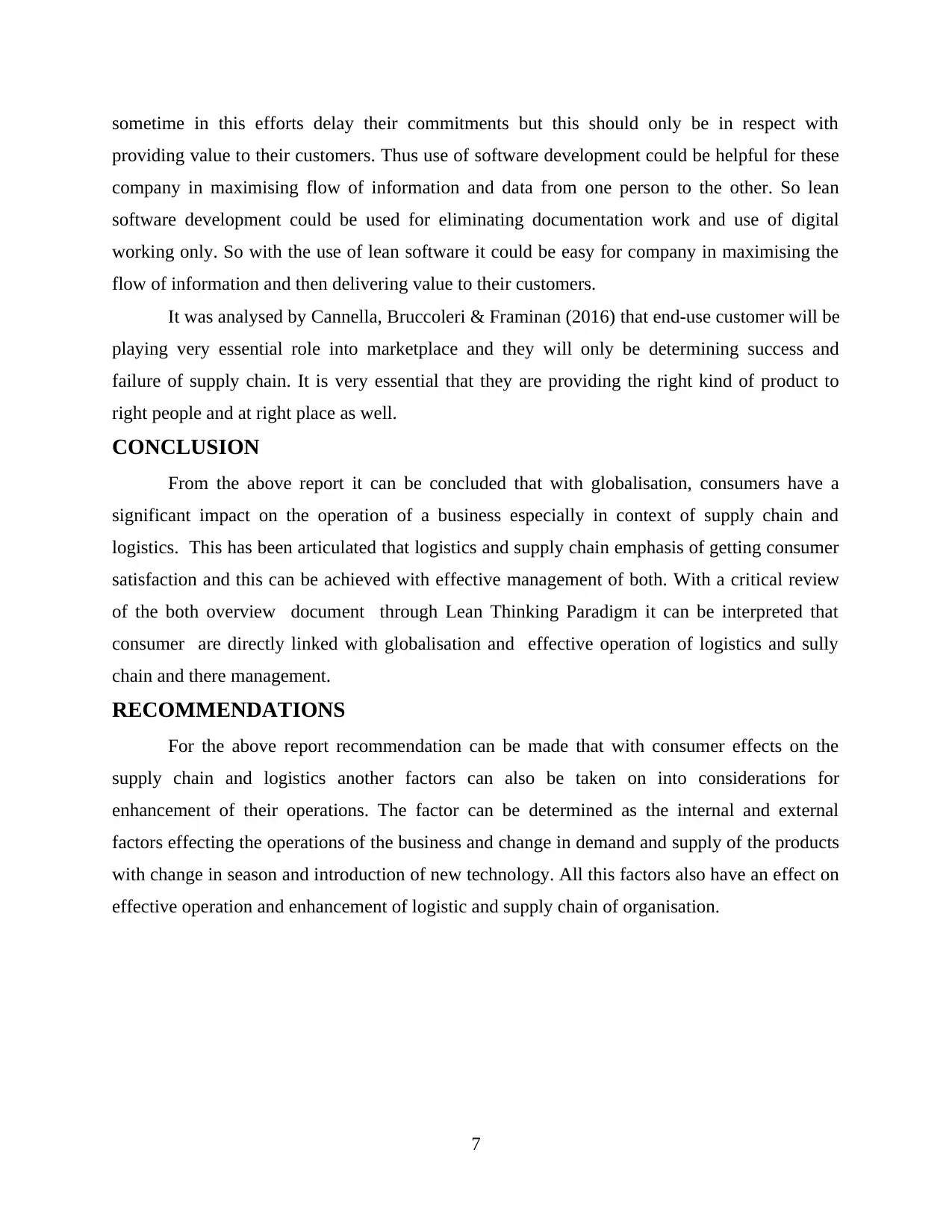
sometime in this efforts delay their commitments but this should only be in respect with
providing value to their customers. Thus use of software development could be helpful for these
company in maximising flow of information and data from one person to the other. So lean
software development could be used for eliminating documentation work and use of digital
working only. So with the use of lean software it could be easy for company in maximising the
flow of information and then delivering value to their customers.
It was analysed by Cannella, Bruccoleri & Framinan (2016) that end-use customer will be
playing very essential role into marketplace and they will only be determining success and
failure of supply chain. It is very essential that they are providing the right kind of product to
right people and at right place as well.
CONCLUSION
From the above report it can be concluded that with globalisation, consumers have a
significant impact on the operation of a business especially in context of supply chain and
logistics. This has been articulated that logistics and supply chain emphasis of getting consumer
satisfaction and this can be achieved with effective management of both. With a critical review
of the both overview document through Lean Thinking Paradigm it can be interpreted that
consumer are directly linked with globalisation and effective operation of logistics and sully
chain and there management.
RECOMMENDATIONS
For the above report recommendation can be made that with consumer effects on the
supply chain and logistics another factors can also be taken on into considerations for
enhancement of their operations. The factor can be determined as the internal and external
factors effecting the operations of the business and change in demand and supply of the products
with change in season and introduction of new technology. All this factors also have an effect on
effective operation and enhancement of logistic and supply chain of organisation.
7
providing value to their customers. Thus use of software development could be helpful for these
company in maximising flow of information and data from one person to the other. So lean
software development could be used for eliminating documentation work and use of digital
working only. So with the use of lean software it could be easy for company in maximising the
flow of information and then delivering value to their customers.
It was analysed by Cannella, Bruccoleri & Framinan (2016) that end-use customer will be
playing very essential role into marketplace and they will only be determining success and
failure of supply chain. It is very essential that they are providing the right kind of product to
right people and at right place as well.
CONCLUSION
From the above report it can be concluded that with globalisation, consumers have a
significant impact on the operation of a business especially in context of supply chain and
logistics. This has been articulated that logistics and supply chain emphasis of getting consumer
satisfaction and this can be achieved with effective management of both. With a critical review
of the both overview document through Lean Thinking Paradigm it can be interpreted that
consumer are directly linked with globalisation and effective operation of logistics and sully
chain and there management.
RECOMMENDATIONS
For the above report recommendation can be made that with consumer effects on the
supply chain and logistics another factors can also be taken on into considerations for
enhancement of their operations. The factor can be determined as the internal and external
factors effecting the operations of the business and change in demand and supply of the products
with change in season and introduction of new technology. All this factors also have an effect on
effective operation and enhancement of logistic and supply chain of organisation.
7
⊘ This is a preview!⊘
Do you want full access?
Subscribe today to unlock all pages.

Trusted by 1+ million students worldwide
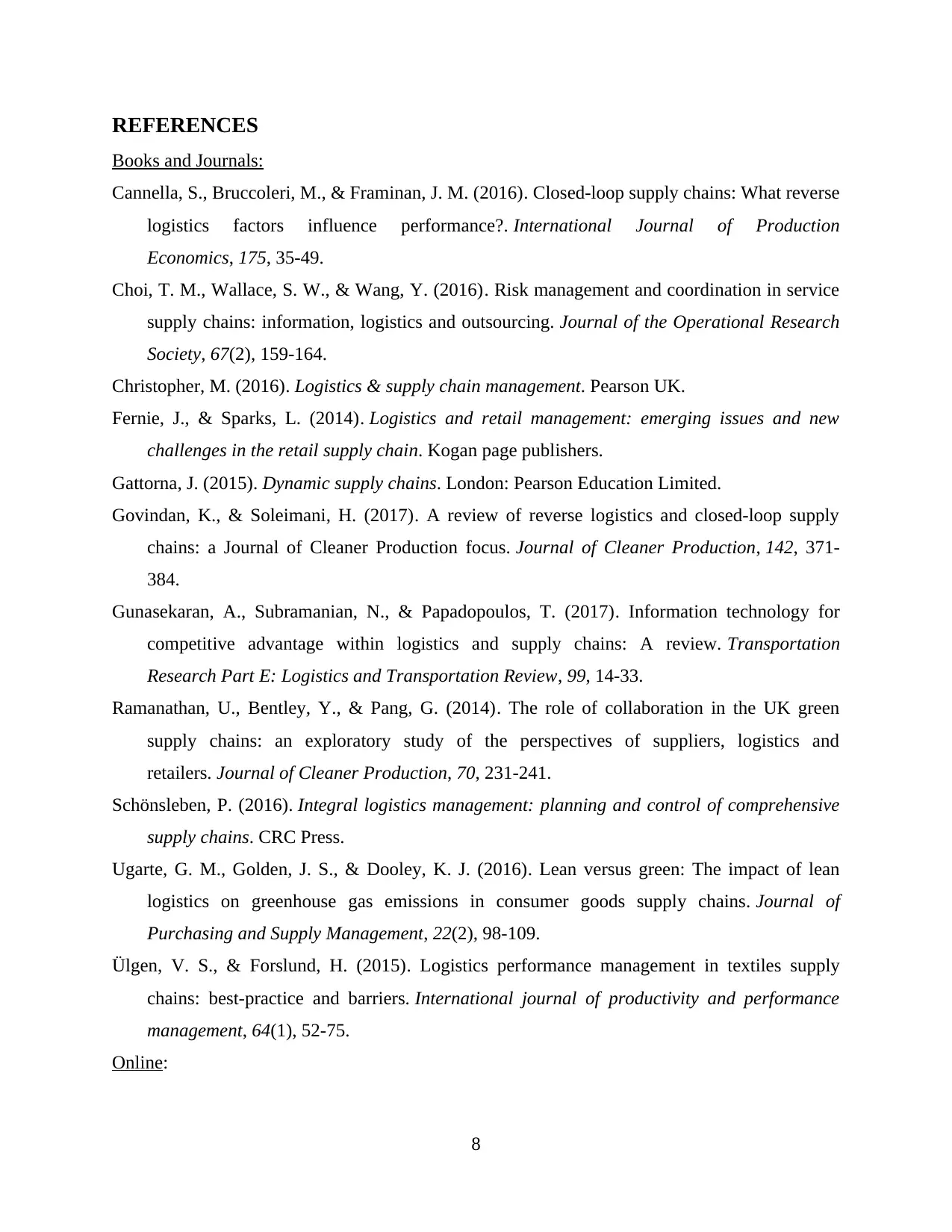
REFERENCES
Books and Journals:
Cannella, S., Bruccoleri, M., & Framinan, J. M. (2016). Closed-loop supply chains: What reverse
logistics factors influence performance?. International Journal of Production
Economics, 175, 35-49.
Choi, T. M., Wallace, S. W., & Wang, Y. (2016). Risk management and coordination in service
supply chains: information, logistics and outsourcing. Journal of the Operational Research
Society, 67(2), 159-164.
Christopher, M. (2016). Logistics & supply chain management. Pearson UK.
Fernie, J., & Sparks, L. (2014). Logistics and retail management: emerging issues and new
challenges in the retail supply chain. Kogan page publishers.
Gattorna, J. (2015). Dynamic supply chains. London: Pearson Education Limited.
Govindan, K., & Soleimani, H. (2017). A review of reverse logistics and closed-loop supply
chains: a Journal of Cleaner Production focus. Journal of Cleaner Production, 142, 371-
384.
Gunasekaran, A., Subramanian, N., & Papadopoulos, T. (2017). Information technology for
competitive advantage within logistics and supply chains: A review. Transportation
Research Part E: Logistics and Transportation Review, 99, 14-33.
Ramanathan, U., Bentley, Y., & Pang, G. (2014). The role of collaboration in the UK green
supply chains: an exploratory study of the perspectives of suppliers, logistics and
retailers. Journal of Cleaner Production, 70, 231-241.
Schönsleben, P. (2016). Integral logistics management: planning and control of comprehensive
supply chains. CRC Press.
Ugarte, G. M., Golden, J. S., & Dooley, K. J. (2016). Lean versus green: The impact of lean
logistics on greenhouse gas emissions in consumer goods supply chains. Journal of
Purchasing and Supply Management, 22(2), 98-109.
Ülgen, V. S., & Forslund, H. (2015). Logistics performance management in textiles supply
chains: best-practice and barriers. International journal of productivity and performance
management, 64(1), 52-75.
Online:
8
Books and Journals:
Cannella, S., Bruccoleri, M., & Framinan, J. M. (2016). Closed-loop supply chains: What reverse
logistics factors influence performance?. International Journal of Production
Economics, 175, 35-49.
Choi, T. M., Wallace, S. W., & Wang, Y. (2016). Risk management and coordination in service
supply chains: information, logistics and outsourcing. Journal of the Operational Research
Society, 67(2), 159-164.
Christopher, M. (2016). Logistics & supply chain management. Pearson UK.
Fernie, J., & Sparks, L. (2014). Logistics and retail management: emerging issues and new
challenges in the retail supply chain. Kogan page publishers.
Gattorna, J. (2015). Dynamic supply chains. London: Pearson Education Limited.
Govindan, K., & Soleimani, H. (2017). A review of reverse logistics and closed-loop supply
chains: a Journal of Cleaner Production focus. Journal of Cleaner Production, 142, 371-
384.
Gunasekaran, A., Subramanian, N., & Papadopoulos, T. (2017). Information technology for
competitive advantage within logistics and supply chains: A review. Transportation
Research Part E: Logistics and Transportation Review, 99, 14-33.
Ramanathan, U., Bentley, Y., & Pang, G. (2014). The role of collaboration in the UK green
supply chains: an exploratory study of the perspectives of suppliers, logistics and
retailers. Journal of Cleaner Production, 70, 231-241.
Schönsleben, P. (2016). Integral logistics management: planning and control of comprehensive
supply chains. CRC Press.
Ugarte, G. M., Golden, J. S., & Dooley, K. J. (2016). Lean versus green: The impact of lean
logistics on greenhouse gas emissions in consumer goods supply chains. Journal of
Purchasing and Supply Management, 22(2), 98-109.
Ülgen, V. S., & Forslund, H. (2015). Logistics performance management in textiles supply
chains: best-practice and barriers. International journal of productivity and performance
management, 64(1), 52-75.
Online:
8
Paraphrase This Document
Need a fresh take? Get an instant paraphrase of this document with our AI Paraphraser

Pohlen, T.L. (2018). Supply Chain Metrics. [Online]. Accessed through:
<https://www.eng.auth.gr/mattas/foodima/lamb5.pdf>.
Principles of Lean Thinking. (2018). [Online]. Accessed through:
<http://www.leanessays.com/2002/11/principles-of-lean-thinking.html>.
SCRIOŞTEANU, A., (2018). CUSTOMER SERVICE – THE IMPORTANT GOAL OF
LOGISTICS. [Online]. Accessed through: <http://feaa.ucv.ro/annals/v1_2012/EVMM-
5.pdf>.
9
<https://www.eng.auth.gr/mattas/foodima/lamb5.pdf>.
Principles of Lean Thinking. (2018). [Online]. Accessed through:
<http://www.leanessays.com/2002/11/principles-of-lean-thinking.html>.
SCRIOŞTEANU, A., (2018). CUSTOMER SERVICE – THE IMPORTANT GOAL OF
LOGISTICS. [Online]. Accessed through: <http://feaa.ucv.ro/annals/v1_2012/EVMM-
5.pdf>.
9
1 out of 11
Related Documents
Your All-in-One AI-Powered Toolkit for Academic Success.
+13062052269
info@desklib.com
Available 24*7 on WhatsApp / Email
![[object Object]](/_next/static/media/star-bottom.7253800d.svg)
Unlock your academic potential
Copyright © 2020–2025 A2Z Services. All Rights Reserved. Developed and managed by ZUCOL.





